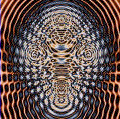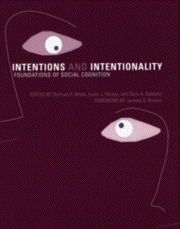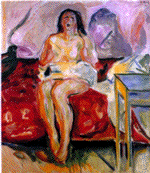La présence éventuelle d'une publicité ci-dessus est insérée par le routeur du mailing-liste indépendamment de mes choix en compensation de la gratuité de son service Dr O Walusinski baillement.com baillement.info yawning.info 

dimanche 1er juin 2003 la lettre d'information du site baillement.com N°20 Si vous ne voyez pas les images, cliquez ici pour lire cette lettre dans votre navigateur. If you cannot see any pictures below, try viewing this letter via your web browser click here baillement.com est libre d'accès, base documentaire pour comprendre, chercher, travailler Next issue on 1 september 2003 Prochain numéro le 1 septembre 2003
Yawning and Migraine : the twosome- Migraine seems to be caused by a combination of environmental and genetic factors. Clinical, pharmacologic evidence and recent genetic findings supports the hypothesis that dopaminergic transmission is involved in the pathogenesis of migraine. Prodromal symptomatology (mood changes, yawning, drowsiness, food craving), accompanying symptoms (nausea, vomiting, hypotension) and postdromal symptoms (mood changes, yawning, drowsiness, tiredness) may be related to dopaminergic activation. The dopaminergic system could also play a role in the headache phase, either by taking part in nociception mechanisms, or by regulating cerebral blood flow. Apomorphine administration induces in migraineurs more yawns as well other dopaminergic symptoms e.g. yawning, nausea, vomiting, dizziness. These findings and others that are here in presentation, support the view that hypersensitivity of peripheral and central dopaminergic receptors is a specific migraine trait.
Bâillement et Migraine : l'association - La migraine semble secondaire à la combinaison de facteurs environnementaux et génétiques. La clinique comme la pharmacologie et de récents développements de la génétique confirment l'hypothèse qu'un dysfonctionnement de la transmission dopaminergique interviendrait dans la physiopathologie de la crise migraineuse. Les prodromes (changements d'humeur, bâillements, somnolence, dégoût alimentaire) et les post-dromes (changements d'humeur, bâillements, somnolence, lassitude) peuvent être reliés à une sur-stimulation dopaminergique. Le système dopaminergique joue aussi un rôle à la phase douloureuse, d'une part en participant aux voies nociceptives, d'autre part en intervenant dans la régulation de la circulation artérielle cérébrale. L'apomorphine induit plus de bâillements chez les migraineux que chez les non-migraineux, ainsi que d'autres symptômes bâillements, nausées,vomissements, étourdissements. Ces données, et d'autres encore présentées ci-dessous, corroborent l'hypersensibilité des récepteurs centraux et périphériques à la dopamine comme aspect spécifique de la migraine.
Dopaminergic hypersensibility in migraine: a diagnostic test ? Hypersensibilité dopaminergique dans la migraine: un test diagnostique ?
- Bès A et al Hypersensibilité dopaminergique dans la migraine: un test diagnostique ? La Nouvelle Presse Médicale1982; 11; 19
- Blau JN Migraine postdromes: symptoms after attacks Cephalagia 1991 Nov; 11; 5; 229-31
- Blin O, Azulay JP, Masson G, Aubrespy G, Serratrice G Apomorphine-induced yawning in migraine patients: enhanced responsiveness Clin Neuropharmacol 1991 Feb; 14; 1; 91-5
- Cerbo R, Barbanti P, Buzzi MG, Fabbrini G, Brusa L, Roberti C, Zanette E, Lenzi GL Dopamine hypersensitivity in migraine: role of the apomorphine test Clin Neuropharmacol 1997 Feb; 20; 1; 36-4
- Del Bene E, M Poggioni Video assessment of yawning induced by sublingual apomorphine in migraine Headache 1994; 34; 9; 536-8
- Del Zompo M Dopamine hypersensitivity in migraine: role in apomorphine syncope Headache 1995; 35; 222-224
- Del Zompo M Association between dopamine receptor genes and migraine without aura in a Sardinian sample Neurology 1998; 51; 3; 781-6
- Fanciullacci M, Alessandri M, Del Rosso A Dopamine involvement in the migraine attack. Funct Neurol 2000; 15 Suppl 3:171-81
- Heinrichs L Linking olfaction with nausea and vomiting of pregnancy, recurrent abortion, hyperemesis gravidarum, and migraine headache Headache 2003; 43; 3; 304-5
- Jacome D Compulsive yawning as migraine premonitory symptom Cephalalgia 2001 Jun; 21; 5; 623-5
- Jacome D Primary yawning headache Cephalalgia 2001 Jul; 21; 6; 697-699
- James MF,Smith J M et al Cortical spreading depression and migraine: new insights from imaging? Trends in Neurosciences May 2001; vol 24; n 5; p 266-271
- Loder A What is the evolutionary advantage of migraine ? Cephalalgia 2002; 22; 624-632
- Peres MF et al Hypothalamic involvement in chronic migraine J Neurol Neurosurg Psychiatry 2001; 71; 747-751
- Peroutka SJ Dopamine and migraine Neurology 1997 Sep; 49; 3; :650-6
- Sabatini U et al Migraine attacks induced by subcutaneous apomorphine in two migrainous parkinsonian patients Clinical Neuropharmacology1990; 13; 3; 264-267
- Le mise au point la plus complète, la plus récente :
- Pietrobon D, Sriessnig J. Neurobiology of migraine
- Nature Neurosciences Reviews may 2003; vol 4; n°5; p386-398
- Szechtman H et al Sensitization and tolerance to apomorphine in men: Yawning, growth hormone, nausea, and hyperthermia Psychiatry Research 1988, 23, 245-255
- «Repeated injections of the dopamine agonist apomorphine sensitize the yawning response, do not affect GH release, and induce tolerance to the drug's effects on nausea and feelings of hyperthermia. In view of the fact that sensitization may be an important element in the development of psychosis, it is suggested that yawning may be a useful "window" onto brain dopamine mechanisms of this abnormality.»
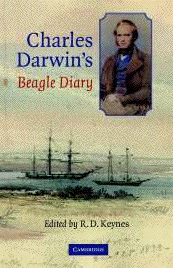
«...seeing a dog and horse and man yawn, makes me feel how much all animals are built on one structure» Charles Darwin 1838 notebook 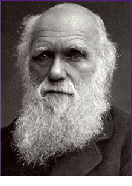
-
3 et 4 octobre 1833. - Un violent mal de tête m'oblige à garder le lit pendant deux jours. Une bonne vieille femme qui me soigne me presse d'essayer une quantité de singuliers remèdes. La plupart du temps, on fixe à chaque tempe du malade une feuille d'oranger ou un morceau de taffetas noir ; il est encore plus usuel de couper une fève en deux, d'humecter ces moitiés et d'en placer une sur chaque tempe, où elles adhèrent facilement. On ne croit pas qu'il soit convenable d'enlever les fèves ou le taffetas ; on les laisse jusqu'à ce qu'ils tombent naturellement. Quelquefois, si on demande à un homme qui a des morceaux de taffetas sur la tête ce qu'il a bien pu se faire, il vous répond : "J'avais la migraine avant-hier." - Charles Darwin Voyage d'un
naturaliste autour du Monde à bord du Beagle de
1831 à 1836
October 3rd and 4th 1833. - I was confined for these two days to my bed by a headache. A good natured old woman, who attended me, wished me to try many odd remedies. A common practice is, to bind an orange-half or a bit of black plaster to each temple: and a still more general plan is, to split a bean into halves, moisten them, and place one on each temple, where they will easily adhere. It is not thought proper, ever to remove the beans or plaster, but to allow them to drop off, and sometimes, if a man, with patches on his head, is asked, what is the matter? he will answer: "I had a headache the day before yesterday."
- Charles Darwin A naturalist
voyage round the World (on the Beagle 1831 -
1836)
What is the evolutionary advantage of migraine ? A Loder Cephalalgia 2002; 22; 624-632 - Charles Darwin was beset throughout his adult
life by recurrent, disabling headaches, and would today
almost certainly be diagnosed as suffering from migraine.
Yet there is no record that he ever speculated on what
might be, as described by his theory of natural
selection, the evolutionary advantage of migraine.
[...] With him originated the now commonly
accepted (but then radical) idea of 'heritable
variability' in living creatures, with its implications
of an unbroken chain of life extending back to a common
ancestor for man and every other creature that ever
lived.
Along with this Darwin developed what is often referred to as the doctrine of 'selection of the fittest': the idea that the forces of natural selection will favour traits that confer on their possessor the most 'fitness' for the environment. Creatures possessing different traits that adapt thern more or less well to their environment will in consequence have different reproductive and survival rates. Even a trait that offers only a slight advantage will, over millions of years of evolution, be strongly selected for, while traits which reduce reproductive fitness even slightly will ultimately be eliminated. Several lines of evidence make clear that susceptibility to migraine is to a large extent genetic, and therefore a trait upon which evolutionary forces must act.
Susceptibility to migraine is determined by genetic factors and is therefore subject to the forces of natural selection. Migraine is a common and ancient disorder whose prevalence may be increasing, suggesting that a migraine-prone nervous system may be associated with reproductive or survival advantages. Five evolutionary explanations are reviewed that might account for the persistence of migraine: (1) migraine as a defence mechanism; (2) migraine as a result of conflict with other organisms; (3) migraine as result of novel environmental factors; (4) migraine as a trade-off between genetic harms and benefits; and (5) migraine as a design constraint. An evolutionary perspective on migraine allows the generation of important hypotheses about the disorder and suggests rewarding possibilities for further research.
- Charles Darwin, célèbre migraineux, ne semble pas s'être posé la question découlant de l'application de la théorie qu'il proposait, originale pour l'époque, et maintenant largement acceptée: quel est l'avantage procurée par la migraine en terme d'évolution ? Connue depuis que les hommes laissent des écrits relatant leurs souffrances, la migraine n'a pas disparue et semble même augmentée de fréquence dans les populations caucasiennes. Ceci suggère un ou des avantages reproductifs et de survie des porteurs de ce trouble. A Loder propose, dans son article, 5 perspectives évolutionnistes concernant la migraine:
- la migraine participe aux défenses de l'organisme; la connaissance de la douleur améliore la survie en prévenant les risques de blessures et autres dommages par crainte de la douleur qu'ils engendrent. La susceptibilité sensorielle (luminosité, odeurs) optimise la perception des situations à risques.
- la migraine est, par ses successions vasomotrices opposées, le résultat d'une adpatation favorable face à une éventuelle cause infectieuse.
- la migraine est le un trait génétique récemment apparu que l'évolution n'a pas encore ou n'a pas de bénéfice à voir disparaître.
- la migraine est le revers des bénéfices génétiquement induits par les avantages que d'autres gènes associés procurent au porteur.
- la migraine témoigne d'un conflit entre structures cérébrales de phylogénèse évolutive différente : diencéphale - aires corticales.
Aspartam:céphalées et bâillements incoercibles
-
« Aspartam gives me a three-day headache. I yawn uncontrollably, feeling tired but not sleepy. Even a spoonful of this product will cause problems. Fortunately, I have found that eating dates will ease my pain. This is good because nothing else will and I am convinced that I loose brain cells every time this happens!
un grand merci auProf Jean Decety qui m'a envoyé ces articles et autorisé leurs téléchargements au format pdf 
l'image du dessein Imiter pour découvrir l'humain Psychologie, neurobiologie, robotique et philosophie de l'esprit Jean Decety et Jacqueline Nadel collection psychologie et sciences de la pensée PUF ed (Paris) A PET Exploration of the Neural Mechanisms Involved in Reciprocal Imitation J Decety, T Chaminade, J Grèzes, AN Meltzoff NeuroImage 2002; 15; 265-272 Is perceptual anticipation a motor simulation ? A PET study T Chaminade, D Meary, JP Orliaguet, J Decety NeuroReport 4/12/01; vol 12; n 17 Does the End Justify the Means? A PET Exploration of the Mechanisms Involved in Human Imitation T Chaminade, AN. Meltzoff, J Decety NeuroImage 2002; vol 15; 318-328 Naturaliser l'empathie Decety J. L'Encéphale 2002, 28 : 9-20 Neural correlates of feeling sympathy Decety J. & Chaminade T. Neuropsychologia Special issue on Social Cognition 2003. 41(2) : 127-138 Empathy: Its ultimate and proximate bases Preston SD, de Waal F Department of Psychology, University of California at Berkeley Living Links, Yerkes Primate Center and Psychology Department, Emory University, Atlanta Empathy and contagion of yawning: a behavioral continuity related to a behavioral discontinuity Deputte BL , Walusinski O Neural mechanisms of empathy in humans: a relay from neural systems for imitation to limbic areas Carr L, Iacoboni M, Dubeau MC, Mazziotta JC, Lenzi GL Proc Natl Acad Sci USA 2003 Apr; 100; 5497-502 The manifold nature of interpersonal relations: the quest for a common mechanism Gallese V Philos Trans R Soc Lond B Biol Sci 2003: 358; 1431; 517-28 Characterization of empathy deficits following prefrontal brain damage: the role of the right ventromedial prefrontal cortex Shamay-Tsoory SG, R Tomer J Cogn Neurosci 2003; 15; 3; 324-37
What imitation tells us about social cognition: a rapprochement between developmental psychology and cognitive neuroscienceAndrew N. Meltzoff & Jean Decety Center for Mind, Brain & Learning, University of Washington, Seattle, WA 98195, USA Phil. Trans. R. Soc. Lond. B 2003; 358, 491Ð500 - At the border of the replication of yawning :
- Both developmental and neurophysiological research suggest a common coding between perceived and generated actions. This shared representational network is innately wired in humans. We review psychological evidence concerning the imitative behaviour of newborn human infants. We suggest that the mechanisms involved in infant imitation provide the foundation for understanding that others are 'like me' and underlie the development of theory of mind and empathy for others. We also analyse functional neuroimaging studies that explore the neurophysiological substrate of imitation in adults. We marshal evidence that imitation recruits not only shared neural representations between the self and the other but also cortical regions in the parietal cortex that are crucial for distinguishing between the perspective of self and other. Imitation is doubly revealing: it is used by infants to learn about adults, and by scientists to understand the organization and functioning of the brain.
- Aux frontières de la replication du bâillement :
- Les recherches actuelles chez l'homme s'accordent sur l'idée que la perception des mouvements et des actions réalisés par autrui, et l'imagerie mentale de l'action partagent avec la génération de l'action intentionnelle un ensemble de régions cérébrales. Cette capacité cognitive est innée. Nous passons ici en revue les données concernant la capacité d'imitation du nouveau-né. Nous suggérons que les mécanismes sous-tendant la capacité de l'enfant à imiter sont à la base de la compréhension que "l'autre est comme moi" et sous-tendent le développement de la théorie de l'esprit et la capacité à partager des émotions ou empathie. Nous passons en revue les études d'imagerie fonctionnelle explorant les capacités d'imitation de l'adulte. Nous montrons ainsi que le cortex pariétal joue un rôle crucial dans la distinction entre le soi et l'autre. Ces études offrent une assise neurophysiologique objective au concept de représentations partagées entre plusieurs personnes qui seraient le fondement de la communication sociale et de l'intersubjectivité. L'imitation prouve deux choses : elle est utilisée par l'enfant pour apprendre au contact des adultes et d'autre part elle permet aux scientifiques de mieux appréhender l'organisation et le fonctionnement du cerveau.
Définir l'empathie : L'empathie est-elle une simulation mentale de la subjectivité d'autrui ? 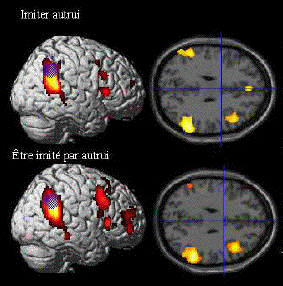
cliché extrait du site du Pr J Decety - Admettant que le développement du cortex
frontal (moteur) et préfrontal (prémoteur)
est spécifique aux bipèdes, on peut
proposer que la replication du bâillement,
véritable échokinésie pour
reprendre ce mot inventé par JM Charcot, est:
- une spécificité humaine interprétée comme un mimétisme comportementale
- - alors que l'observation d'un comportement moteur d'autrui est mimée par les aires motrices de l'observateur et le plus souvent non suivi d'actes moteurs par inhibition frontale, le bâillement serait-il, lui, sous certaine condition de niveau de vigilance, le résultat d'une imitation non inhibée ?
- - la replication du bâillement aurait conféré un avantage sélectif en permettant une synchonisation efficace des niveaux de vigilance entre les membres d'un groupe. Elle participerait d'une forme d'empathie instinctive involontaire, probablement apparue tardivement au cours de l'évolution des primates.(J Decéty : «un composant de l'empathie est la résonance motrice dont le déclenchement est le plus souvent automatique et non intentionnel et qui plonge ses racines dans l'histoire évolutive de nos ancêtres les primates non humains»)
- Andrew N. Meltzoff : «It is important to distinguish between emotional contagion and true empathy, which is different in that it involves the capacity to hold both your own emotional state and another's simultaneously - rather than to just "catch" their emotion and feel it as your own. On the basis of the research in infants, emotional contagion precede empathy in developmental terms and preceding both of these, in the very youngest newborn babies, is the ability to imitate another's actions and expressions.»
- voir aussi :
- Neural systems involved in "Theory of Mind" M Siegal & R Varley
- Nature Reviews Neuroscience june 2002; vol 3; p463-471
- Neural basis of deciding, choosing, and acting J. Schall
- Nature Reviews Neuroscience january 2001; vol2; p33-42
- The neurochemical hypothesis of "theory of mind" A. Abu-Akel
- Medical Hypotheses 2003; 60; 3; p382-386
- Contagious yawning: the role of self-awareness and mental state attribution Platek SMet al.
-
Intentions and Intentionality - Foundations of Social Cognition - edited by B.E Malle, L.J.Moses and D.A. Baldwin, MIT Press, 2001 (434 pages)
- We are social animals, and evolution has selected
mechanisms that facifitate our social behavior and our
learning of the rules that are embodied in the culture in
which we happen to find ourselves. This is true for the
neonate and continues throughout life. One mechanism that
facilitates social understanding is our ability to
understand others as intentional and to predict the
behavior of others on the basis of their beliefs and
desires.
Intentions and Intentionality is a continuation of the discussion of the concept of intentionality in modern inquiry. The book represents a conference that brought together a number of leading figures in the field to discuss their somewhat diverse views about the concept of intentionality and how it functions as an essential factor for social cognition and social understanding. It includes some of the history of thinking about intentionality and, importantly, extends the line of thinking to include the social. After reading, you can have another and original point of vue about the yawn's replication .
Nous sommes des être sociaux. L'évolution a sélectionné des méchanismes qui facilitent notre comportement social et l'apprentissage des règles permettant une communication implicite avec autrui et qui seraient à la base de l'intersubjectivité. Ceci est vrai depuis la naissance et tout au long de l'existence. Un des méchanismes qui facilite la compréhension sociale, chez l'homme, est sa capacité à comprendre les autres comme des agents intentionnels, c'est-à-dire dotés d'intentions, de désirs et de croyances.
- Ce livre est une riche compilation rédigée par une kyrielle d'auteurs, venant d'horizons variés, apportant pour chacune des disciplines concernées, leurs conceptions sur «la notion d'intentionalité et d'intention», données fondamentales pour comprendre la cognition sociale. L'approche historique de ces concepts, tel que donner un sens aux comportements humains, n'est pas oubliée. A lire pour aborder sous un angle nouveau et original la replication du bâillement.
-
Edvard Munch (1863-1944) - Norwegian painter and printmaker whose intense,
evocative treatment of psychological and emotional themes
was a major influence on the development of German
Expressionism in the early 20th century. His painting The
Cry (1893) is regarded as an icon of existential anguish.
I thanks Gianluca Ficca for his idea to present
this painting"Morning yawn" (1913).
Peintre norvégien, Edvard Munch par ses thèmes intensémment chargés d'émotion, par sa puissance évocatrice des troubles psychologiques a grandement influencé le développement de l'expressionisme allemand à l'aube du XX° siècle. Sa peinture le cri (1893) est encore considérée comme une icone de l'angoisse existentielle. Sur une idée de Gianluca Ficca, j'ai le plaisir de vous proposer son tableau "bâillement matinal"(1913).
- Munch Museum
- Bergen Art Museum
- Musée de L'Albertina : réouverture du célèbre Musée de Vienne qui abrite une expo consacrée à Munch jusqu'au 23 juin 2003
- Gianluca Ficca & Piero Salzarulo "Lo Sbadiglio Dello Struzzo", Bollati Boringhieri, Torino, 2002
Un grand merci à JR Eguibar et SP Vickers qui m'ont envoyé spontanément leurs articles
-
Autres documents mis en ligne ce mois-ci :
- Yawning produced by dopamine agonists in rhesus monkeys RA Code, AHTang
- Antagonism of apomorphine-induced yawning by SCH 23390: Evidence against the autoreceptor hypothesis Morelli M et al
- What is the evolutionary advantage of migraine ? Loder A
- Effects of different periods of lithium pretreatment and aminoglycoside antibiotics on apomorphine-induced yawning in rats Sharifzadeh M et al
- Behavioral differences between selectively bred rats: D1 versus D2 receptors in yawning and grooming Eguibar JR et al
- GB Duchenne de Boulogne 1806 - 1875
- L'histoire des neurosciences à La Pitié et à La Salpêtrière J Poirier
- The history of neurosciences at La Pitié and La Salpêtrière J Poirier
- Sensitization and tolerance to apomorphine in men: yawning, growth hormone, nausea, and hyperthermia Szechtman H et al
- Induced grooming transitions and open field behaviour differ in high- and low-yawning sublines of Sprague-Dawley rats Moyaho A et al
- Preferential effects of the cannabinoid CB(1) receptor antagonist, SR 141716, on food intake and body weight gain of obese ( fa/fa) compared to lean Zucker rats Vickers SP
- Hyperplexia Hassib Narchi
- Hypersensibilité dopaminergique dans la migraine: un test diagnostique ? Bès A et al
- Association between dopamine receptor genes and migraine without aura in a Sardinian sampleDel Zompo M et al
- Migraine attacks induced by subcutaneous apomorphine in two migrainous parkinsonian patients U Sabatini et al
- Antagonism of the apomorphine-induced yawning by atypical neuroleptics Dubuc I, Protais P et al
- Télécharger PDF l'intégralité des données PubMed "yawning " (613 ref,152p) au 31 mai 2003

- Si vous avez déjà utilisé le lexique de ce site, vous avez constaté que certaines définitions relevant de la pharmacologie renvoient vers l'excellent site spécialisé du Professeur Pierre Allain. Celui-ci a eu l'amabilité de me questionner sur les bâillements et les médicaments. Vous pouvez retrouver ces données sur son site.
Liefde is gaapverwekkend3 mai 2003 Supplément du week-end de ce journal Hollandais qui expose les résultats de la thèse de psychologie de Wolter Seuntjens

Yawning in Dutch Le bâillement en Flamand avec les illustrations du site http://www.baillement.com
Résultats du sondageau 31 mai 2003
-
Nombre de questionnaires remplis : 878 - Combien de fois bâillez-vous par jour ? <5 = 25,6%.. 5-10 = 25,6%.. 10-15 = 15,3%.. 15-20 = 9,5%.. >20 = 24%
- Ressentez-vous des baillements excessifs ?
- 76% = non, tant
mieux
25,9% = oui et je ne sais pas pouquoi - 5,9% = oui et je prends des antidépresseurs
- 1,3% = oui et je prends
des anti-épileptiques
4,7% = oui et je prends d'autres médicaments
2,5% = oui et j 'ai des troubles neurologiques
1,9% = oui et j 'ai des troubles hormonaux
2,8% = oui et j 'ai des tics moteurs
1,7% = oui et j 'ai des tocs - déclenchez-vous facilement le bâillement d'autrui ? 74,6%
- êtes-vous sensible au bâillement d'autrui ? 74,1%
- L'espèce humaine, aux diverses périodes de son évolution, a passé successivement par le sentiment, la raison et l'expérience. D'abord, le sentiment seul s'imposait à la raison avec les vérités de foi, c'est-à-dire la théologie. La raison ou la philosophie, devenant la maitresse, enfanta la scolastique. Enfin, l'expérience, c'est-à-dire, l'étude des phénomènes naturels, apprit à l'homme que les vérités du monde extérieur ne se trouvent formulées ni dans le sentiment ni dans la raison. Ce sont seulement nos guides indispensables; mais, pour obtenir ces vérités, il faut nécessairement descendre dans la réalité objective des choses, où elles se trouvent cachées avec leur forme phénoménale. C'est ainsi qu'apparut, par le progrès naturel des choses, la méthode expérimentale qui résume tout, et qui s'appuie successivement sur les trois branches de ce trépied immuable : le sentiment, la raison, l'expérience.
- Claude Bernard cité par GE Gilles de la Tourette - l'hypnotisme et les états analogues (Plon et Nourrit ed - Paris 1887)
baillement.com baillement.info yawning.info écrits et réalisés par le Dr Walusinski
Voici le nombre d'abonnés à cette lettre : courriel à adresser lire les lettres précédentes d'information du site
You can meethttp://yawning.info in Lyon
"The paradox of sleep: An unfinished storyAn international meeting in the honor of Michel Jouvet" Lyon, les 3 et 4 septembre 2003 L'affiche www.baillement.com à Lyon The poster www.yawning.info in Lyon
